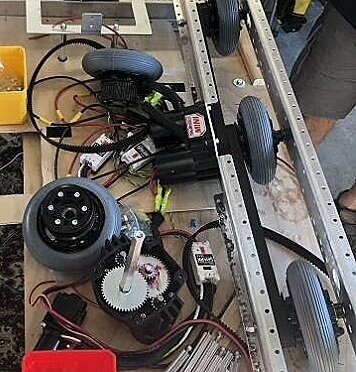Pneumatic Wheel Integration
Written by Rishita Dhalbisoi
Making a change from the Hi-Grip wheels used the previous year, the team concluded on using 6-inch pneumatic wheels for the 2021 season. We came to this decision based on the great range of speed and maneuverability offered by the wheels, as well as the acceleration they yield. Our next steps after receiving the pneumatic ones from AndyMark was deciding how to build and integrate it.
Upon arrival, the team started assembling the wheels by inflating the pneumatic inner tube. Once the inflated tube was placed in the interior of the grippy rubber tire, the top and bottom of the strong plastic hub were put into place. After a couple of hours of assembly, our six wheels were finally ready!
The next step was to remove our old wheels, the ones used for the 2020 season. A long series of unscrewing bearings and screws to take apart the shafts and separate the metal parts of our chassis began. The side parts were then ready to wedge the pneumatic wheels in. Keeping in mind the partial inch raise needed for the fitting of the wheels, we began with the middle wheel that would be put on the right side of the robot. Once getting it between with the use of pressure, it helped lay the structure for the next two wheels. The wedged gap allowed for the implementation of the wheels left and right of the middle with the use of a shaft. Given that the side of the middle wheel facing the robot’s interior was attached to the motor, the power is communicated to the outer wheels with the use of two rubber tracks. This process of assembly was then repeated on the left side of the robot. We then reassembled our chassis, marking the completion of integrating our new wheels!


